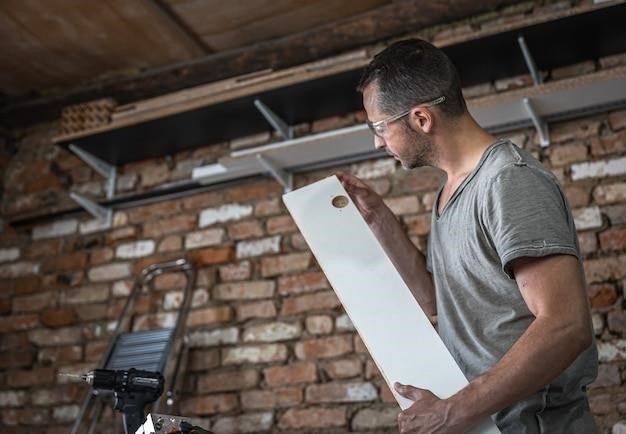Wood Frame Construction Manual⁚ A Comprehensive Guide

This manual provides a comprehensive guide to wood frame construction, covering everything from the basics of design and construction to advanced topics like connections, wall systems, floor and roof systems, and code compliance. It is an essential resource for builders, architects, engineers, and homeowners who are interested in learning more about this popular and versatile construction method.
Introduction
The Wood Frame Construction Manual (WFCM) is a comprehensive guide to the design and construction of wood-framed buildings, specifically for one- and two-family dwellings. It is a valuable resource for architects, builders, engineers, and homeowners seeking guidance on best practices and code compliance in this construction method. The manual is developed and published by the American Wood Council (AWC), a leading organization in the wood building industry, and it is widely referenced in building codes across North America. The WFCM provides detailed information on various aspects of wood frame construction, including design provisions, structural elements, connections, wall systems, floor and roof systems, and code compliance. It aims to promote safe, efficient, and sustainable building practices while ensuring that structures meet the required standards for durability and performance.
The WFCM is regularly updated to reflect advancements in wood construction technology, changes in building codes, and evolving industry standards. It is a living document that provides a roadmap for building professionals and homeowners to navigate the complexities of wood frame construction. The manual’s clear and concise writing style, coupled with its comprehensive scope, makes it an indispensable tool for anyone involved in the design, construction, or maintenance of wood-framed buildings.
Key Features of Wood Frame Construction
Wood frame construction, a cornerstone of residential and light commercial building, boasts a multitude of advantages that have solidified its popularity over decades. It stands out for its versatility, allowing for diverse architectural designs and customizations. The inherent flexibility of wood enables the creation of various shapes, sizes, and configurations, catering to a wide range of building needs. This adaptability is particularly advantageous for complex designs or projects with unique requirements.
Another key feature is the cost-effectiveness of wood frame construction. Compared to other building materials, wood is generally more affordable, making it an attractive option for budget-conscious projects. This cost efficiency extends beyond the initial material cost, as wood frame construction often translates to faster construction timelines, reducing labor expenses and overall project costs.
Sustainability is also a prominent feature of wood frame construction. Wood is a renewable resource, offering an environmentally responsible alternative to materials with higher carbon footprints. Furthermore, the use of wood in construction promotes energy efficiency, contributing to a greener building footprint. The natural insulation properties of wood help regulate indoor temperatures, reducing the reliance on heating and cooling systems, thus contributing to a more sustainable and energy-efficient building.
Design and Construction Provisions
The Wood Frame Construction Manual (WFCM) outlines comprehensive design and construction provisions that ensure the structural integrity, safety, and durability of wood frame buildings. These provisions address various aspects of the construction process, from foundation design and framing techniques to roof systems and wall assemblies. The manual emphasizes the importance of using appropriate materials, adhering to established standards, and implementing proper construction practices.
The WFCM incorporates provisions for load calculations, taking into account dead loads (weight of the building itself), live loads (occupancy loads and furniture), snow loads, seismic loads, and wind loads. These provisions ensure that the building is designed to withstand anticipated forces and stresses, contributing to its structural stability and safety. The manual also details requirements for connections, specifying the types of fasteners, connectors, and joinery methods that should be used to create strong and durable connections between structural elements.
Furthermore, the WFCM includes guidelines for insulation, vapor barriers, and air sealing. These provisions aim to create energy-efficient buildings that are comfortable and cost-effective to operate. By minimizing heat loss and air infiltration, the manual promotes improved indoor air quality and reduced energy consumption, contributing to a more sustainable and environmentally responsible building.
Structural Elements
The Wood Frame Construction Manual (WFCM) provides comprehensive guidance on the selection and use of various structural elements commonly employed in wood frame construction. These elements form the skeletal framework of the building, providing support and stability for the walls, floors, and roof. The manual covers a wide range of materials, including sawn lumber, structural glued laminated timber, wood structural panel sheathing, I-joists, and trusses, each with its specific characteristics and applications.
Sawn lumber, a traditional building material, is used extensively in wood frame construction for framing walls, floors, and roofs. It is available in various sizes and grades, providing flexibility in design and construction. Structural glued laminated timber, composed of layers of wood veneer bonded together with adhesive, offers high strength and stiffness, making it suitable for larger spans and heavy loads. Wood structural panel sheathing, used as a covering over framing members, enhances the structural integrity of walls and roofs, providing additional shear strength and stiffness.
I-joists, manufactured wood beams with a web of engineered lumber sandwiched between two flanges, are lightweight and strong, ideal for floor and roof systems. Trusses, assembled from individual pieces of lumber connected to form a triangular structure, offer efficient load-bearing capacity and span long distances, making them suitable for roofs and floors. The WFCM provides detailed information on the properties, applications, and installation methods for these structural elements, ensuring their safe and effective use in wood frame construction.
Connections and Wall Systems
The Wood Frame Construction Manual (WFCM) delves into the critical aspects of connections and wall systems, highlighting the importance of strong and durable connections for ensuring the structural integrity of wood frame buildings. The manual provides detailed guidance on various connection methods, including nailing, screwing, bolting, and gluing, emphasizing the appropriate techniques for different applications and load conditions.
The WFCM also explores various wall systems commonly employed in wood frame construction, outlining their design considerations, construction details, and performance characteristics. These systems include conventional stud walls, platform framing, balloon framing, and shear walls, each offering distinct advantages and limitations. Conventional stud walls, built with vertical studs spaced 16 or 24 inches apart, are widely used in residential construction for their simplicity and cost-effectiveness. Platform framing, involving the construction of floors in horizontal layers, provides a stable and secure platform for subsequent walls and roof construction.
Balloon framing, a traditional method where studs run continuously from the foundation to the roof, offers greater stability but requires careful attention to fire safety. Shear walls, designed to resist lateral loads from wind and earthquakes, play a crucial role in enhancing the structural stability of wood frame buildings. The WFCM provides comprehensive information on these wall systems, enabling builders to select the most suitable system based on the specific requirements of the project, ensuring the safety and performance of the building.
Floor and Roof Systems
The Wood Frame Construction Manual (WFCM) provides comprehensive guidance on designing and constructing safe and efficient floor and roof systems for wood frame buildings. It covers a wide range of structural elements, including sawn lumber, structural glued laminated timber, wood structural panel sheathing, I-joists, and trusses, offering a variety of options for different load requirements and architectural designs.
For floor systems, the WFCM details various construction techniques, including joist layouts, subfloor installation, and floor sheathing, emphasizing the importance of proper spacing and support for ensuring adequate strength and stiffness. The manual also addresses the use of engineered lumber products, such as I-joists and laminated veneer lumber (LVL), which offer greater span capabilities and reduced material consumption compared to traditional sawn lumber.
Roof systems are also thoroughly covered in the WFCM, with specific guidance on rafter design, roof sheathing, and the use of roof trusses. The manual emphasizes the need for proper roof slope and drainage to prevent water infiltration and damage. It also provides recommendations for incorporating insulation and ventilation within the roof assembly to improve energy efficiency and comfort.
Code Compliance and Standards
The Wood Frame Construction Manual (WFCM) emphasizes adherence to building codes and standards to ensure the safety, durability, and energy efficiency of wood frame structures. It references the International Residential Code (IRC) as the primary source for code requirements and provides specific guidance on how to meet these requirements in various aspects of wood frame construction.
The WFCM delves into design loads for various scenarios, including dead loads, live loads, snow loads, seismic loads, and wind loads, derived from provisions of the ASCE 7-10 standard. It outlines methods for calculating these loads and applying them to the design and construction of structural elements. The manual also highlights the importance of using approved materials, such as those listed in the American Wood Council (AWC) Wood Design Standards, to ensure proper performance and compliance.
Furthermore, the WFCM emphasizes the importance of proper inspection and documentation throughout the construction process. It encourages builders to work closely with building officials and inspectors to ensure that the project meets all code requirements and to obtain necessary approvals. The manual also provides resources for accessing building codes, standards, and other relevant documents.
Resources and Further Reading
For those seeking to delve deeper into the intricacies of wood frame construction, numerous resources and further reading materials are readily available. The American Wood Council (AWC) website, a leading authority on wood construction, offers a wealth of information, including technical publications, design guides, and educational materials. Their Wood Frame Construction Manual (WFCM) is a cornerstone resource, providing comprehensive guidance on design and construction practices.
The International Code Council (ICC), responsible for developing and maintaining model building codes, also provides valuable resources. Their website offers access to the International Residential Code (IRC), which sets the standards for residential construction, as well as other relevant codes and standards.
Beyond these primary sources, various professional organizations, such as the National Association of Home Builders (NAHB) and the National Frame Builders Association (NFBA), offer educational programs, workshops, and publications on wood frame construction. Additionally, numerous books, articles, and online courses provide in-depth knowledge on specific aspects of wood frame construction, covering topics such as design, engineering, construction techniques, and building science.
